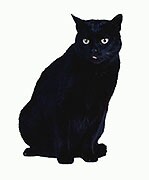
TUESDAY, Feb. 25, 2014 (HealthDay News) — Feeding obese cats more frequent, smaller meals throughout the day could increase their level of physical activity and help them lose weight, new research suggests.
Offering meals with water added to the food also spurred adult cats to become more active, scientists found in their study of 10 lean, neutered cats.
“I think veterinarians will be interested in this information because it gives them evidence to be able to recommend something to pet owners that could help with feline obesity and diabetes,” study leader Kelly Swanson, an animal sciences researcher at the University of Illinois, said in a school news release.
“When cats are allowed to feed [freely], it’s difficult to prevent obesity,” Swanson said. “It is important to identify the right diet. Many owners are accustomed to dumping a pile of food out for multiple cats, just once per day.”
Swanson said cat owners must play an active role in helping their pets maintain a healthy weight.
“It all comes down to energy in and energy out,” he said. “It’s very simple on paper, but it’s not that easy in real life, especially in a household where there is more than one pet. That can be difficult, but I think these two strategies are very practical ideas that people can use.”
In conducting the study, which was published in the February issue of the Journal of Animal Science, the researchers measured cats’ level of physical activity between meals with special monitors on their collars.
In one experiment, the cats were placed in one of four rooms. They were fed meals of dry kibble either four times each day, two times daily or once a day, or were given meals at random. All the cats received the same total amount of food each day, but those that ate more frequently ate smaller amounts at each meal.
In another experiment, the cats were split up into two rooms, where they were fed twice a day. The amount of food the cats ate was the same, but water was added to one group’s food an hour before feeding.
To closely monitor their diet, the researchers placed cats in individual cages during mealtime. During meals, the cats had little human contact.
The researchers assessed the cats’ activity two hours before they ate. In the first part of the experiment, cats were more active before mealtime, particularly those who were fed four times per day and those fed a random number of meals each day.
“If they know they are going to get fed, that’s when they are really active, if they can anticipate it,” Swanson said.
Cats were even more physically active when they ate food with added water, the researchers found. The biggest spike in activity occurred after the cats ate. Although it is unclear why the cats had this surge in activity after eating, the researchers suggested use of the litter box could have played a role.
Most owners make the mistake of overfeeding their cats, the researchers said.
“Because most pet foods are so digestible and nutrient dense, owners see that small bowl of food and think there’s no way they can survive on that — but they can,” Swanson said. “It is tricky because labels on pet food provide ranges for how much should be fed. If you’re feeding a cat, that food is supplied to thousands of cats with different metabolism. Some are spayed or neutered, and ages are different.”
One way owners can help their cats lose weight is to add water to their dry food to give them a greater sense of fullness. Another option is to alternate between wet and dry meals.
Although many pet owners are not able to be home to feed their cats up to four times a day, even just going from one to two meals a day can help cats become more active and lose extra pounds, the researchers said.
“With cats, one of the tricky things is that few people can walk their cats,” Swanson said. “We haven’t done studies looking at what happens if you are just in the room with the cat more often and how active you can encourage your cat to be by playing with it. There could be other strategies. From a diet perspective, this is something that is relatively simple.”
More information
The ASPCA has more about overweight cats.
Copyright © 2026 HealthDay. All rights reserved.

